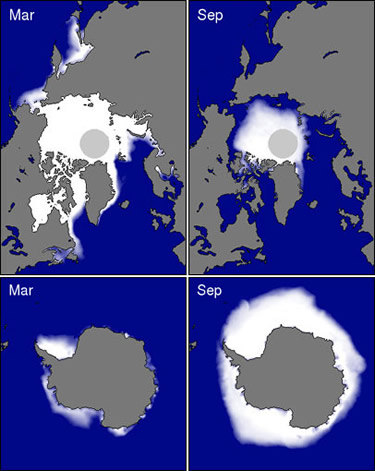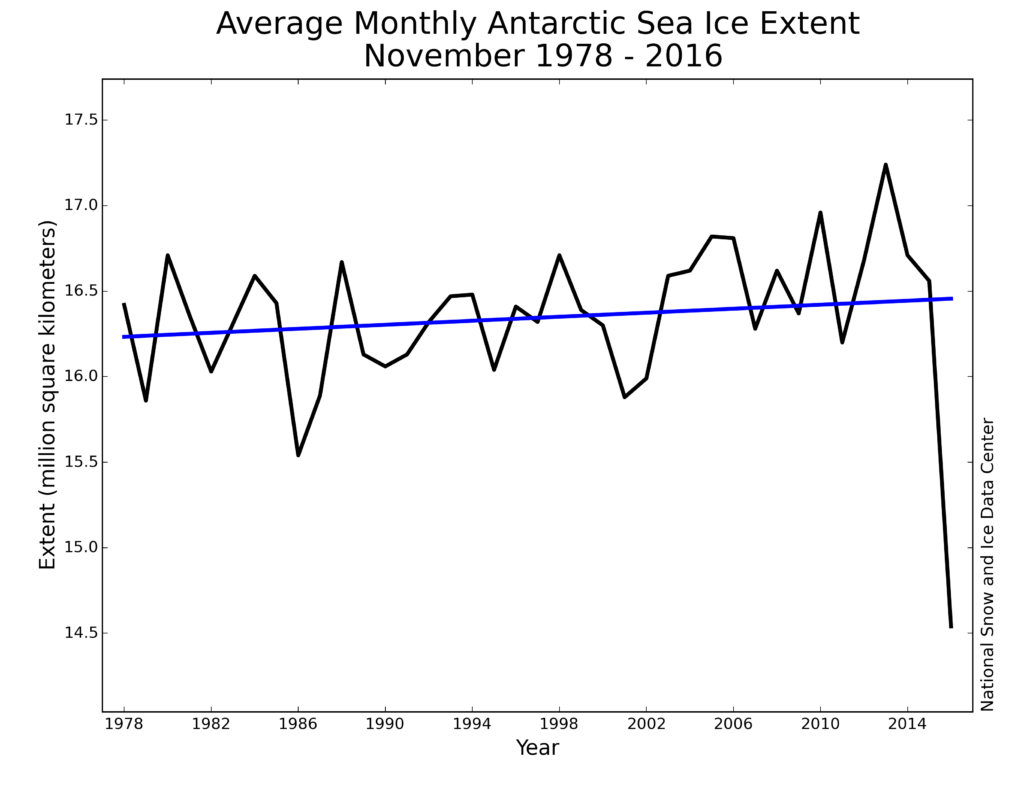Rebecca Frew (postgraduate research student, Reading), 22 January 2018
What are some of the main differences between Arctic and Antarctic sea ice?
- The Arctic is an ocean surrounded by continent, whilst the Antarctic is a continent surrounded by ocean. This means that Antarctic sea ice is free to move more equator-ward, into warmer waters and melt. The Antarctic therefore has very little multiyear ice, meaning that average ice thickness is around 1-2m, which is lower than the average 2-3m in the Arctic.
- Snowfall is much greater in the Southern Ocean than in the Arctic. The combination of higher snowfall rates and thinner sea ice means that snow ice formation is more common in the Antarctic. Snow ice forms when the snow is heavy enough to push the top of the sea ice below the water surface, flooding some of the snow with sea water which then freezes.
- The thick snow covering makes it difficult to get reliable Antarctic sea ice thickness measurements. This means we are unsure as to how Antarctic sea ice volume, as opposed to extent, has been changing.

Figure 1: Average maximum and minimum ice concentration for March and September using satellite data from 1979-2000. The seasons are opposite for the two poles, as one is at its maximum the other is at its minimum. Figure taken from https://nsidc.org/cryosphere/seaice/characteristics/difference.html
How has Antarctic sea ice been changing?
Antarctic sea ice extent has actually been increasing slightly overall! This small increasing trend (shown in Figure 2) is the sum of opposing regional trends. The Weddell and Ross seas have shown an increasing trend and the Amundsen and Bellingshausen (A-B) seas have shown a decreasing trend (see Figure 3).

Figure 2: Average monthly Antarctic sea ice extent time series in black, with the small increasing trend in blue. Figure taken from: http://nsidc.org/arcticseaicenews/2016/12/arctic-and-antarctic-at-record-low-levels/

Figure 3: Map of seasonal trend in ice concentra-tion. Maximum trends are seen in summer. Large increases are seen in the Weddell and Ross seas, and decreases in the Amundsen and Bellingshau-sen (A-B) seas. Figure taken from Holland (2014)
However, these trends aren’t apparent in all seasons. In all regions the trends grow in spring, resulting in the maximum trends in the summer, which decay in autumn, and no significant trend is seen in the winter ice concentration (Holland 2014, doi:10.1002/2014GL060172).
In other words, there are no significant trends in ice concentration if you look at winter values, however we do see trends when looking at a time series of summer values. The seasonality of the trends implies that feedbacks are involved, amplifying the trends in spring (positive feedbacks) and damping them in the autumn (negative feedbacks).
Why hasn’t Antarctic sea ice extent been decreasing?
There is no clear consensus on this, in short we don’t know… and it is not the intuitive response to global warming, and this makes Antarctic sea ice interesting! We only have a 38 year time series of Antarctic sea ice extent, so we can’t be sure how this time series relates to natural variability on decadal and longer timescales. It is relatively accepted that modes of natural variability such as the El Nino Southern Oscillation (ENSO) and the Southern Annular Mode (SAM) play a role in Antarctic sea ice variability, and can explain some of the trends we have observed in some sectors. Anthropogenic forcing such as the ozone hole and increased ice sheet freshwater discharge could also play a role, although the magnitude of impact of each individual factor is unclear.
Currently global climate models are poor at reproducing the observed Antarctic sea ice changes, showing a decrease in sea ice extent failing to reproduce the correct spatial trends (Turner et al. 2013, doi:10.1002/2013GL058371). This makes it very hard to make predictions about future changes in Antarctic sea ice, and implies that there are processes or feedbacks with the sea ice that are missing from our models that are important in dictating the Antarctic sea ice cover.
When will it start to decrease?
Again, we just don’t know… It’s hard to say whether the low Antarctic sea ice extent observed in 2017 is the start of a reverse in Antarctic sea ice trend or just an anomaly. Our low confidence in global climate models to give us a realistic estimate means we will just have to wait and see.
References
Holland, P. R., 2014: The seasonality of Antarctic sea ice trends. Geophys. Res. Lett.,41, 4230–4237, doi:10.1002-/2014GL060172.
Turner, J., T. J. Bracegirdle, T. Phillips, G. J. Marshall, and J. S. Hosking, 2013: An initial assessment of Antarctic sea ice extent in the CMIP5 models. J. Climate, 26, 1473–1484.
